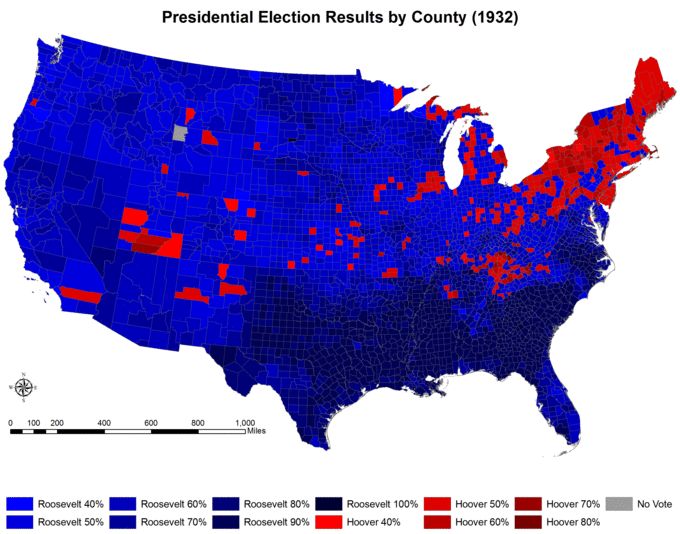ELECTION IN THE MIDST OF THE GREAT DEPRESSION
As the presidential election of 1932 took place in the midst of the Great Depression, the economy was unsurprisingly the dominant issue. With unemployment rate at nearly 24%, heavy industries barely functioning, and dramatically low prices of farm products, Herbert Hoover, the incumbent Republican president, faced unprecedented challenges. Although the Great Depression hit countries all around the world, Hoover was held largely responsible for the consequences of the crisis in the United States. His reelection became even more questionable when Franklin Delano Roosevelt, the successful and popular governor of New York, won the Democratic nomination.
FDR
In 1930, Roosevelt was reelected governor of New York by a wide margin. The demonstrated support in the most populous state of the country, substantial political experience, and good connections (voters still remembered the presidency of his fifth cousin and Republican Theodore Roosevelt) convinced many that FDR could win an election where such cultural issues as Catholicism, prohibition, or Ku Klux Klan would not play a decisive role. By the time of the 1932 convention in Chicago, FDR was the leading candidate but was still short of the support of the required two-thirds of the delegates. However, his campaign managers, James Farley and Louis McHenry Howe, convinced House Speaker John Nance Garner of Texas to drop out of the race. Roosevelt won the nomination on the fourth ballot and, as a return favor, named Garner his running mate. Famously breaking the political tradition, he appeared at the Convention and personally accepted the nomination.
On the Republican side, Charles Curtis remained Hoover's running mate.
CAMPAIGN
Hoover was so unpopular that Roosevelt's campaign revolved cautiously around blaming Hoover for the disastrous economic situation and making vague promises of programs and reforms that would lead the country towards economic recovery. In a campaign speech in Iowa, FDR accused "the present Administration of being the greatest spending Administration in peacetime in all our history." Garner joined his running mate claiming that Hoover was "leading the country down the path of socialism."
While Roosevelt run on New Deal slogans, he had no clear idea what the program would entail and offered no specific proposals. His team of advisers, known as the Brain Trust, suggested he did not go beyond such general points as aid for farmers, public development of electric power, a balanced budget, or business regulations. Even prohibition, Democrats' favorite target, was discussed in terms of an economic issue as bringing back alcohol could not be disconnected from the question of associated tax revenues. The optimistic yet vague tone of Roosevelt's campaign was captured in his iconic campaign song "Happy Days Are Here Again," which became one of the most popular songs in American political history and the unofficial anthem of the Democratic Party.
Unlike Roosevelt, Hoover was unable to achieve either unity within his party or popularity among voters. Many prominent Republicans vehemently opposed him while others simply refused to support the incumbent. Some went as far as to support Roosevelt. As Hoover's presidency was now defined by the Great Depression, his political attacks on Roosevelt did not convince the voters. Neither was the Republican candidate himself particularly appealing. Hoover's reportedly grim personality contrasted with Roosevelt's optimism and confidence. The incumbent president was so unpopular that at times, voters threw objects at him when he was campaigning in public.
A LANDSLIDE WIN
Predictably, Roosevelt won the election by a landslide. Roosevelt and Garner received over 57% and Hoover and Curtis over 39% of the popular vote. The electoral vote was 472 to 59. Of all the regions, only New England supported Hoover and the Democratic ticket carried 42 states. Democrats also won majority in both houses of Congress.
The 1932 election realigned political loyalties and coalitions in the United States. By attracting the wide and diverse base of new voters, including organized labor, urban middle and working class, including white ethnic communities (Irish Americans, Polish Americans, Jews, etc.), racial minorities, white Southerners, farmers, and progressive intellectuals, the Democratic party became the majority party. This realignment transformed American politics, creating what is called the New Deal Party System or the Fifth Party System.
ROOSEVELT'S INAUGURAL SPEECH
On March 3, 1933, Roosevelt addressed the nation in his first inaugural speech. Once again, the Great Depression was in the center of everyone's attention. Roosevelt did not avoid difficult topics. He talked about dramatic unemployment, poverty, high taxes, fallen industries, and farmers who could not find markets for their products. "Only a foolish optimist," he noted, "can deny the dark realities of the moment." Yet, Roosevelt offered a dose of realistic optimism, when he promised government relief and recovery programs in cities and in the countryside as well as regulation of big businesses. He repeatedly compared the Great Depression to war and assured Americans that the massive economic crisis would be treated with the state of emergency typical of war emergencies. He also signaled a more internationalist attitude than most of his isolationist predecessors. Appealing to the sense of national unity and recognition that eventual success would come only with the hard work of all, Roosevelt told his compatriots what would become one of the most inspirational lines in Americans history, "[T]he only thing we have to fear is fear itself—nameless, unreasoning, unjustified terror which paralyzes needed efforts to convert retreat into advance. In every dark hour of our national life a leadership of frankness and vigor has met with that understanding and support of the people themselves which is essential to victory. I am convinced that you will again give that support to leadership in these critical days."

Presidential Election Results by County (1932)
Blue counties voted for Roosevelt, red for Hoover--darker shades indicate wider margins. The map indicates Roosevelt's wide base of support.